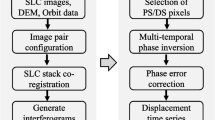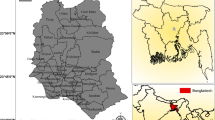Abstract
Many former military training sites contain unexploded ordnance (UXO) and require environmental remediation. For the first phase of UXO remediation, locations of geomagnetic anomalies are recorded over a subregion of the study area to infer the spatial intensity of anomalies and identify high concentration areas. The data resulting from this sampling process contain locations of anomalies across narrow regions that are surveyed; however, the surveyed regions only constitute a small proportion of the entire study area. Existing methods for analysis require selecting a window size to transform the partially surveyed point pattern to a point-referenced dataset. To model the partially surveyed point pattern and infer intensity of anomalies at unsurveyed regions, we propose a Bayesian spatial Poisson process model with a Dirichlet process mixture as the inhomogeneous intensity function. A data augmentation step is used to impute anomalies in unsurveyed locations and reconstruct clusters of anomalies that span surveyed and unsurveyed regions. To verify that data augmentation reconstructs the underlying structure of the data, we demonstrate fitting the model to simulated data, using both the full study area and two different sampled subregions. Finally, we fit the model to data collected at the Victorville Precision Bombing range in southern California to estimate the intensity surface in anomalies per acre.
Supplementary materials accompanying this paper appear online.





Similar content being viewed by others
References
Antoniak, C. E. (1974), ‘Mixtures of Dirichlet processes with applications to Bayesian nonparametric problems’, The Annals of Statistics pp. 1152–1174.
Baddeley, A., Chang, Y.-M. and Song, Y. (2013), ‘Leverage and influence diagnostics for spatial point processes’, Scandinavian Journal of Statistics40(1), 86–104.
Baddeley, A., Rubak, E., Møller, J. et al. (2011), ‘Score, pseudo-score and residual diagnostics for spatial point process models’, Statistical Science26(4), 613–646.
Baddeley, A., Rubak, E. and Turner, R. (2015), Spatial Point Patterns: Methodology and Applications with R, Chapman and Hall/CRC Press.
Baddeley, A. and Turner, R. (2005), ‘Spatstat: An R package for analyzing spatial point patterns’, Journal of Statistical Software12(6), 1–42.
Baddeley, A., Turner, R., Møller, J. and Hazelton, M.(2005), ‘Residual analysis for spatial point processes (with discussion)’, Journal of the Royal Statistical Society: Series B (Statistical Methodology)67(5), 617–666.
Brix, A. and Møller, J. (2001), ‘Space-time multi type log Gaussian Cox processes with a view to modelling weeds’, Scandinavian Journal of Statistics28(3), 471–488.
Burnham, K. P., Anderson, D. R. and Laake, J. L. (1980), ‘Estimation of density from line transect sampling of biological populations’, Wildlife monographs (72), 3–202.
Carvalho, C. M., Lopes, H. F., Polson, N. G., Taddy, M. A. et al.(2010), ‘Particle learning for general mixtures’, Bayesian Analysis5(4), 709–740.
Cressie, N. (1991), Statistics for Spatial Data, Wiley.
Cressie, N. and Lawson, A. B. (2000), ‘Hierarchical probability models and Bayesian analysis of mine locations’, Advances in Applied Probability32(2), 315–330.
Diggle, P. (2013), Statistical Analysis of Spatial and Spatio-Temporal Point Patterns, 3rd edn, CRC Press.
Eddelbuettel, D. and Sanderson, C. (2014), ‘Rcpparmadillo: Accelerating R with high-performance c++ linear algebra’, Computational Statistics and Data Analysis71, 1054–1063.
Gabriel, E., Bonneu, F., Monestiez, P. and Chadœuf, J.(2016), ‘Adapted Kriging to predict the intensity of partially observed point process data’, Spatial Statistics18, 54–71.
Gabriel, E., Coville, J. and Chadœuf, J. (2017), ‘Estimating the intensity function of spatial point processes outside the observation window’, Spatial Statistics22, 225–239.
Hathaway, J. R., McKenna, S. and Pulsipher, B. (2007), Application of statistically based site characterization tools to Victorville Precision Bombing Ranges Y and 15 for the ESTCP wide area assessment demonstration, Technical report, Environmental Security Technology Certification Program. https://www.serdp-estcp.org/content/download/5978/81382/file/MM-0325-Victorville.pdf
Ji, C., Merl, D., Kepler, T. B. and West, M. (2009), ‘Spatial mixture modelling for unobserved point processes: Examples in immunofluorescence histology’, Bayesian Analysis4(2), 297.
MacDonald, J. A. and Small, M. J. (2006), ‘Assessing sites contaminated with unexploded ordnance: statistical modeling of ordnance spatial distribution’, Environmental Science & Technology40(3), 931–938.
Matzke, B., Wilson, J., Newburn, L., Dowson, S., Hathaway, J., Sego, L., Bramer, L. and Pulsipher, B. (2014), Visual Sample Plan Version 7.0 User’s Guide, Pacific Northwest National Laboratory, Richland, Washington. http://vsp.pnnl.gov/docs/PNNL-23211.pdf
Møller, J. and Waagepetersen, R. (2007), ‘Modern spatial point process modelling and inference’, Scandinavian Journal of Statistics34, 643–711.
Møller, J. and Waagepetersen, R. P. (2003), Statistical Inference and Simulation for Spatial Point Processes, CRC Press.
Ogata, Y. (1988), ‘Statistical models for earthquake occurrences and residual analysis for point processes’, Journal of the American Statistical Association83(401), 9–27.
R Core Team (2018), R: A Language and Environment for Statistical Computing, R Foundation for Statistical Computing, Vienna, Austria. https://www.R-project.org/
Sanderson, C. and Curtin, R. (2016), ‘Armadillo: a template-based c++ library for linear algebra’, Journal of Open Source Software.
Taddy, M. A., Kottas, A. et al. (2012), ‘Mixture modeling for marked poisson processes’, Bayesian Analysis7(2), 335–362.
Teh, Y. W. (2010), ‘Dirichlet process’, Encyclopedia of machine learning pp. 280–287.
Teh, Y. W. (2011), Dirichlet process, in ‘Encyclopedia of Machine Learning’, Springer, pp. 280–287.
Van Lieshout, M. and Baddeley, A. (2002), Extrapolating and interpolating spatial patterns, in A. Lawson and D. Denison, eds, ‘Spatial Cluster Modelling’, CRC Press, chapter 4, pp. 61–86.
Waagepetersen, R. and Schweder, T. (2006), ‘Likelihood-based inference for clustered line transect data’, Journal of Agricultural, Biological, and Environmental Statistics11(3), 264.
Acknowledgements
Our many thanks go to John Hathaway for providing the Victorville Precision Bombing Range data. We also thank Megan Higgs for her guidance and mentorship throughout the research process, and for reviewing drafts of this manuscript with her fine attention to detail. Finally, we thank Kate Catlett and Neptune & Company, Inc., for asking tough questions about UXO remediation and providing for the application. This research topic would not have come to our attention were it not for Neptune striving for the highest possible standards of statistical rigor in their work.
Author information
Authors and Affiliations
Corresponding author
Additional information
Publisher's Note
Springer Nature remains neutral with regard to jurisdictional claims in published maps and institutional affiliations.
Electronic supplementary material
Below is the link to the electronic supplementary material.
Rights and permissions
About this article
Cite this article
Flagg, K.A., Hoegh, A. & Borkowski, J.J. Modeling Partially Surveyed Point Process Data: Inferring Spatial Point Intensity of Geomagnetic Anomalies. JABES 25, 186–205 (2020). https://doi.org/10.1007/s13253-020-00387-2
Received:
Accepted:
Published:
Issue Date:
DOI: https://doi.org/10.1007/s13253-020-00387-2




